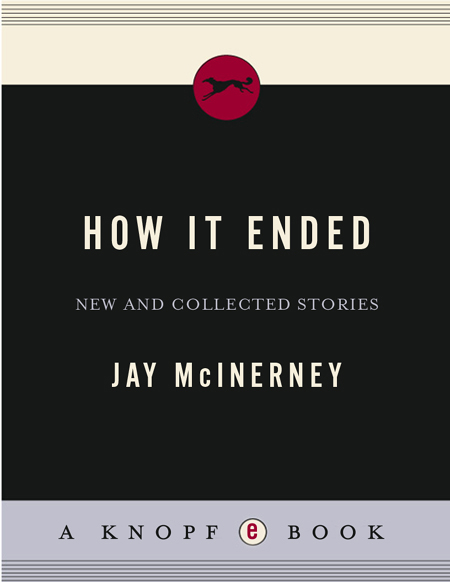
How It Ended
New and Collected Stories
کتاب های مرتبط
- اطلاعات
- نقد و بررسی
- دیدگاه کاربران
نقد و بررسی

January 26, 2009
These 26 stories—some new, some previously published—go back as many years and take readers to a time when the stock market was bullish and a young writer made his name with an ingeniously packaged first novel that perfectly captured a brief moment in time. In this collection, we become reacquainted with the nameless night-crawling narrator of Bright Lights, Big City
; with Alison Poole, the party girl of Story of My Life
(and who McInerney has said was based on John Edwards’s former mistress Rielle Hunter); and Collin McNab, a would-be screenwriter who enjoys a tortuous relationship with his model girlfriend. We also meet new characters, among them a novice screenwriter who learns to play the Hollywood game a little too well, a woman who contemplates sleeping with an old flame on the eve of his wedding, and, in the title story, a drug dealer whose good luck streak repulses the lawyer to whom he confides his tale. While nobody can channel urban strivers and their shallow pursuits as well as McInerney, after a while, the stories all tend to blur together with a depressing predictability.

February 15, 2009
From McInerney (The Good Life, 2006, etc.), a collection of 26 stories spanning some three decades.
The stories fall into two general categories. Many of the earliest ones provided the seeds for novels, and they remind us how fresh the young writer's voice seemed when he made his breakthrough with Bright Lights, Big City (1984). Other stories similarly introduce the characters, voice and themes that would be extended in novels such as Story of My Life (1988), Brightness Falls (1992) and Model Behavior (1998). Comparatively disappointing are the later stories, many of them written since his 2000 story collection published in England (also titled How It Ended). Some of the same obsessions remain—glamour, drugs, nightlife, the endless redundancy of parties—yet the freshness of tone has curdled into clich. It's hard to determine whether the author is writing about protagonists who are pretentiously shallow, adulterous, often aspiring writers who have fallen short of their potential, or whether such protagonists are merely stand-ins for the writer. It's also hard to write about these stories without giving the endings away, but too many of them rely on twists that O. Henry might have rejected as ironically glib, resolutions that are just too pat in their climactic revelations. Then there's the sledgehammer imagery: A dog's invisible fence serves as a metaphor for a couple's sexual transgressions, a potbellied pig in the conjugal bed provides commentary on a husband's proclivities. And so on.
The wit and the engaging voice in the best of these stories aren't enough to offset the impression that neither the third nor the second acts of the novelist's career have fulfilled the promise or equaled the accomplishment of the first.
(COPYRIGHT (2009) KIRKUS REVIEWS/NIELSEN BUSINESS MEDIA, INC. ALL RIGHTS RESERVED.)

April 1, 2009
If the stories in this new collection from McInerney ("Bright Lights, Big City") have a common ground, it's cocaine and parties. Some of these stories are about characters at opposite ends of the universe. Others feel like Noah Baumbach films, concerned with selfish, chemically imbalanced rich families, making it "nearly" impossible to identify with them despite what are supposed to be universal problems. The writing here is clearly good and the narration calm, understated, and nicely controlleda trait McInerney probably picked up while studying under Raymond Carver, though these stories don't feel necessary, as Carver's do. In fact, these bite-sized stories are so smooth, each encapsulating a snippet of its characters' lives, that they can be read in just a few minutes. Some do get to universal truths on heartbreaking relationships, but only in the last few lines; mostly, they're like sitcoms. Not recommended, though libraries where McInerney is popular should consider. [See Prepub Alert, "LJ" 12/08.]Stephen Morrow, Athens, OH
Copyright 2009 Library Journal, LLC Used with permission.

Starred review from February 1, 2009
McInerneys name is most associated with his splashy first novel, Bright Lights, Big City (1985), which helped define contemporaryurban-chic fiction. Other novels followed, and it may come as a surprise to readers of such trendy fiction as McInerneys that he is a splendid short-story writer. He writes about the same people and places as in his novels;on the other hand, he certainly understands the special qualities of the short story, saying in the preface to this career-spanning collection of 26 stories thata good one requires perfect pitch and a precise sense of form; it has to burn with a hard, gem-like flame.His stories are reminiscent of those of F. Scott Fitzgerald, John OHara, and Irwin Shaw (in fact, a line from McInerneys Smoke refers to women in their summer dresses, and one of Shaws most famous stories is entitled Girls in Their Summer Dresses). McInerney shares withthese predecessorsa focus on the appurtenances of his characters: that is, the personal accessoriesthat give away the characters social status and intentions (but McInerney contemporizes his stories by detailing what drugs his characters take). A New York slant colorsevery story, even those not actually set there (as in The Business, in which a New York writer transplants himself to L.A. to write screenplays). Another outstandingstory is The Queen and I, a brief, beautiful instance of self-recognition in the streets of Manhattans meatpacking district (Poised on high heels, undulant with the exaggerated shimmy of courtship, a race of lanky stylized bipeds commands the street corners). A very compelling collection.(Reprinted with permission of Booklist, copyright 2009, American Library Association.)

























دیدگاه کاربران